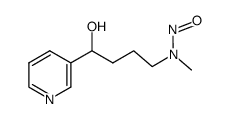nnal

nnal structure
|
Common Name | nnal | ||
|---|---|---|---|---|
| CAS Number | 76014-81-8 | Molecular Weight | 209.24500 | |
| Density | 1.16g/cm3 | Boiling Point | 430.2ºC at 760 mmHg | |
| Molecular Formula | C10H15N3O2 | Melting Point | N/A | |
| MSDS | USA | Flash Point | 214ºC | |
| Symbol |



GHS02, GHS06, GHS08 |
Signal Word | Danger | |
|
Quantitation of metabolites of 4-(methylnitrosamino)-1-(3-pyridyl)-1-butanone after cessation of smokeless tobacco use.
Cancer Res. 62(1) , 129-34, (2002) Two major metabolites of the tobacco-specific lung carcinogen 4-(methylnitrosamino)-1-(3-pyridyl)-1-butanone (NNK) were previously shown to be highly persistent in human urine after cessation of cigarette smoking. We hypothesized that NNK or its metabolite, 4... |
|
|
Evidence for endogenous formation of N'-nitrosonornicotine in some long-term nicotine patch users.
Nicotine Tob. Res. 11(1) , 99-105, (2009) Nitrosation of nicotine or its metabolites in the human body could lead to formation of the 2 carcinogenic tobacco-specific nitrosamines-N'-nitrosonornicotine (NNN) and 4-(methylnitrosamino)-1-(3-pyridyl)-1-butanone (NNK).We investigated the possibility of en... |
|
|
Comparative metabolism of the tobacco-related carcinogens benzo[a]pyrene, 4-(methylnitrosamino)-1-(3-pyridyl)-1-butanone, 4-(methylnitrosamino)-1-(3-pyridyl)-1-butanol, and N'- nitrosonornicotine in human hepatic microsomes.
Drug Metab. Dispos. 25(2) , 154-62, (1997) We compared the metabolism in human hepatic microsomes of three tobacco smoke carcinogens believed to be involved in the induction of cancer in humans: benzo[a]pyrene (BaP),4-(methylnitrosamino)-1-(3-pyridyl)-1-butanone (NNK), and N'-nitrosonomicotine (NNN). ... |
|
|
Preparation of pyridine-N-glucuronides of tobacco-specific nitrosamines.
Chem. Res. Toxicol. 14(5) , 555-61, (2001) Nicotine and cotinine are metabolized to pyridine-N-glucuronides in humans. This suggests that the analogous metabolites of the carcinogenic nicotine-related nitrosamines N'-nitrosonornicotine (NNN), 4-(methylnitrosamino)-1-(3-pyridyl)-1-butanone (NNK), and 4... |
|
|
Effects of long term dietary phenethyl isothiocyanate on the microsomal metabolism of 4-(methylnitrosamino)-1-(3-pyridyl)-1-butanone and 4-(methylnitrosamino)-1-(3-pyridyl)-1-butanol in F344 rats.
Carcinogenesis 18(9) , 1715-22, (1997) Phenethyl isothiocyanate (PEITC), a cruciferous vegetable component, inhibits lung tumor induction by the tobacco specific nitrosamine, 4-(methylnitrosamino)-1-(3-pyridyl)-1-butanone (NNK). To gain insight into the mechanism of PEITC lung tumor inhibition, we... |
|
|
Use of precision-cut tissue slices in organ culture to study metabolism of 4-(methylnitrosamino)-1-(3-pyridyl)-1-butanone (NNK) and 4-(methylnitrosamino)-1-(3-pyridyl)-1-butanol (NNAL) by hamster lung, liver and kidney.
Toxicology 144(1-3) , 83-91, (2000) The pharmacokinetics of in vitro metabolism of the tobacco-specific nitrosamine, 4-(methylnitrosamino)-1-(3-pyridyl)-1-butanone (NNK; concentration range 0.03-250 microM) and its proximal metabolite, 4-(methylnitrosamino)-1-(3-pyridyl)-1-butanol (NNAL; 0.04-2... |
|
|
Absolute configuration of 4-(methylnitrosamino)-1-(3-pyridyl)-1-butanol formed metabolically from 4-(methylnitrosamino)-1-(3-pyridyl)-1-butanone.
Carcinogenesis 18(9) , 1851-4, (1997) 4-(Methylnitrosamino)-1-(3-pyridyl)-1-butanol (NNAL) is an important metabolite of the tobacco-specific nitrosamine 4-(methylnitrosamino)-1-(3-pyridyl)-1-butanone (NNK). Using the chiral derivatizing agent, (R)-(+)-alpha-methylbenzyl isocyanate [(R)-(+)-MBIC]... |
|
|
Metabolism of 4-(methylnitrosamino)-1-(3-pyridyl)-1-butanone (NNK) in human placental microsomes.
Biochem. Pharmacol. 50(11) , 1933-41, (1995) The tobacco-specific nitrosamine 4-(methylnitrosamino)-1-(3-pyridyl)-1-butanone (NNK) can be activated metabolically by cytochrome(s) P450 to DNA-damaging agents that result in the formation of tumors in various organs of several animal models. In the present... |
|
|
Formation and metabolism of 4-(methylnitrosamino)-1-(3-pyridyl)-1-butanol enantiomers in vitro in mouse, rat and human tissues.
Carcinogenesis 21(6) , 1233-8, (2000) 4-(Methylnitrosamino)-1-(3-pyridyl)-1-butanol (NNAL) is a major metabolite of the tobacco-specific lung carcino- gen 4-(methylnitrosamino)-1-(3-pyridyl)-1-butanone (NNK). NNAL has a chiral center at the 1-position, but little is known about the stereochemical... |
|
|
Promotional effects of 4-(methylnitrosamino)-1-(3-pyridyl)-1-butanol (NNAL) on N-nitrosobis(2-oxopropyl)amine (BOP)-initiated carcinogenesis in hamsters.
Food Chem. Toxicol. 35(3-4) , 387-92, (1997) The effects of administration of low doses of 4-(methylnitrosamino)-1-(3-pyridyl)-1-butanol (NNAL), a tobacco-specific nitrosamine, were investigated in hamsters treated with N-nitrosobis(2-oxopropyl)amine (BOP). Female Syrian golden hamsters were given a sin... |